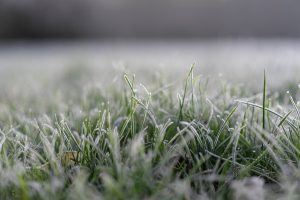
Believe it or not, you CAN lay sod in the winter! It’s true, grass is dormant and not the healthy green color it will be in the spring, which is why many people wonder if the grass will survive. The sod will take root at a much slower rate, but there are benefits to sodding in the colder weather.
You will use less water planting in the winter, and, once the warmer weather wakes the dormant grass, it will quickly turn green and begin to grow. In fact, not laying sod and leaving bare soil through the winter can make your yard turn muddy and be susceptible to erosion. It can also wash away the nutrient-filled topsoil, making it harder for sod to grow when you lay it in the spring.
Can I Install Sod on Frozen Ground?
The answer is yes, but only as long as you have already properly prepped where you are going to lay the sod. By this we mean the area must have been cleared of any existing vegetation and the soil has been tilled, ideally to 4-6 inches deep. The ground should be level and fertilizer should have been added to the soil to the proper pH.
Be sure to lay the sod seam to seam without gaps. Water the sod after installing by using a garden hose. The grass may freeze, but it won’t harm the dormant grass. Be sure to unhook your hose after use to prevent breaking the hose bib.
Can I Lay Frozen Sod?
Frozen sod cannot be put down, as it will most likely break rather than unroll, and cutting frozen sod is incredibly difficult. Defrost the sod by waiting to install it on a warmer day or move it to a heated garage or shed. Don’t let it get too hot, however, as this could kill it.
Some Key Points to Laying Sod in the Winter
Be sure to select the proper sod for your area and soil type. Talk to a local sod expert and let him or her know how much sun, shade, and water your lawn will get. Ask for any special tips to keeping it healthy, lush, and weed-free.
Make sure you get the right amount of sod to cover the area you are going to sod. It can be tricky to measure when you have rounded areas, so again, ask your sod expert if you need help. You don’t want to have gaps between the sod rolls, nor overlapping. If you have extra, simply cut it with a knife or shovel to line it up seam to seam.
When you are laying the sod, do so on dampened ground. Beginning along a straight edge, lay the sod in a brick wall like pattern. When laying sod on a slope, especially in the winter, be sure to do it perpendicular to reduce the chance of it sliding, help prevent erosion, and to support the grass taking root.
Use a sod roller to remove air pockets. This helps prevent dryness and other harm caused by the cold air, snow, and wind in the winter months.
While your sod doesn’t need the same amount of water it does in warmer months, you will still want to keep it moist for it to root in the spring. Ask your sod expert about proper watering and maintenance for your specific sod project. If you’re looking to transform your lawn and increase curb appeal, contact us today to learn about the areas we serve and the best sod products near you.
